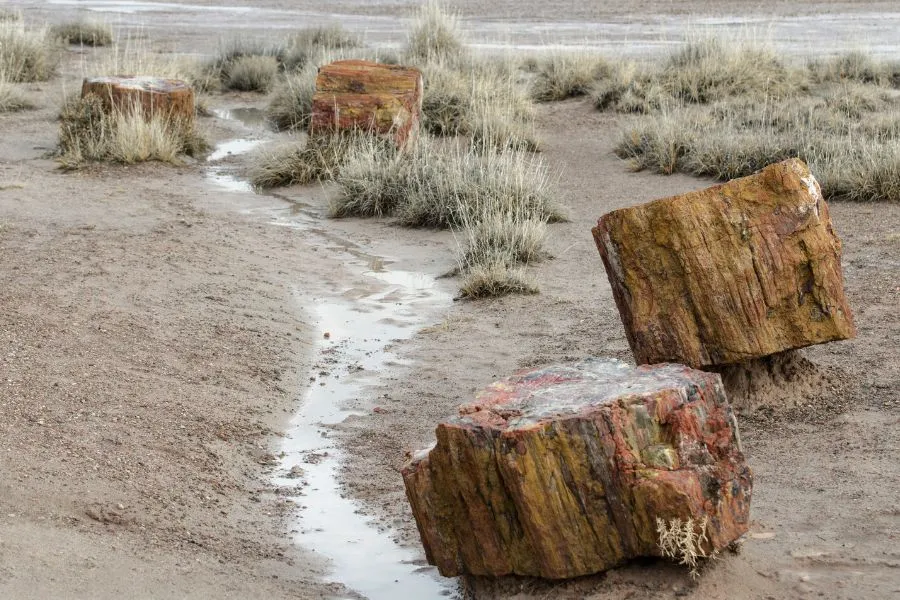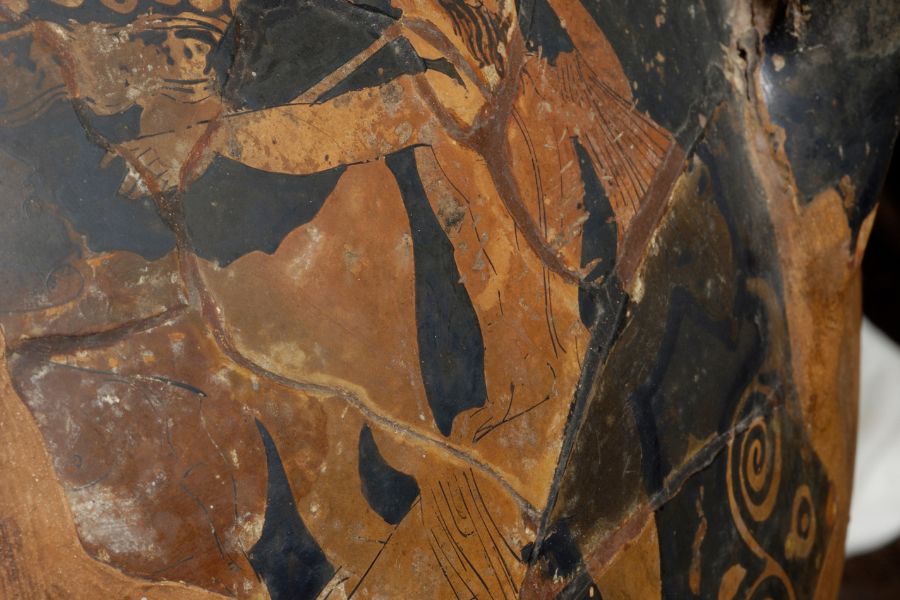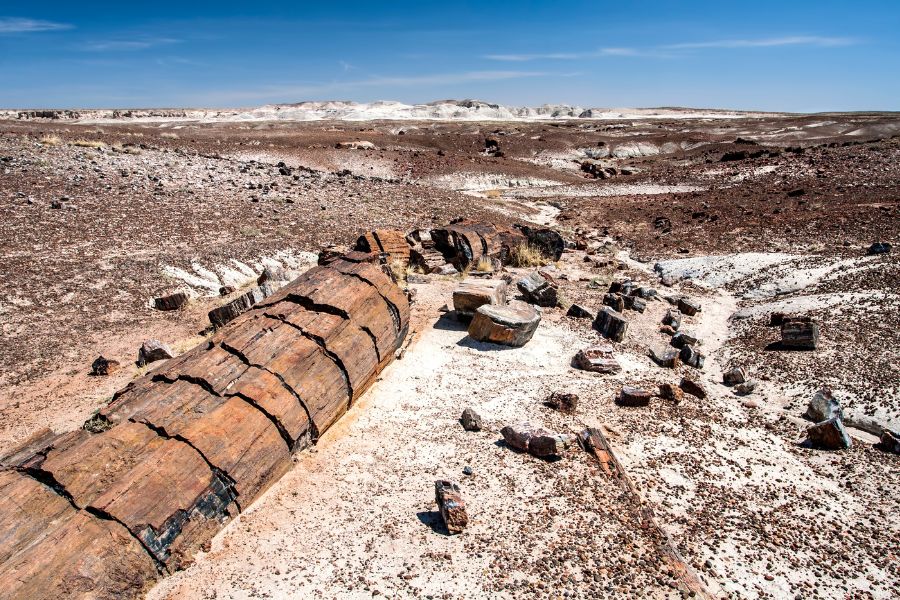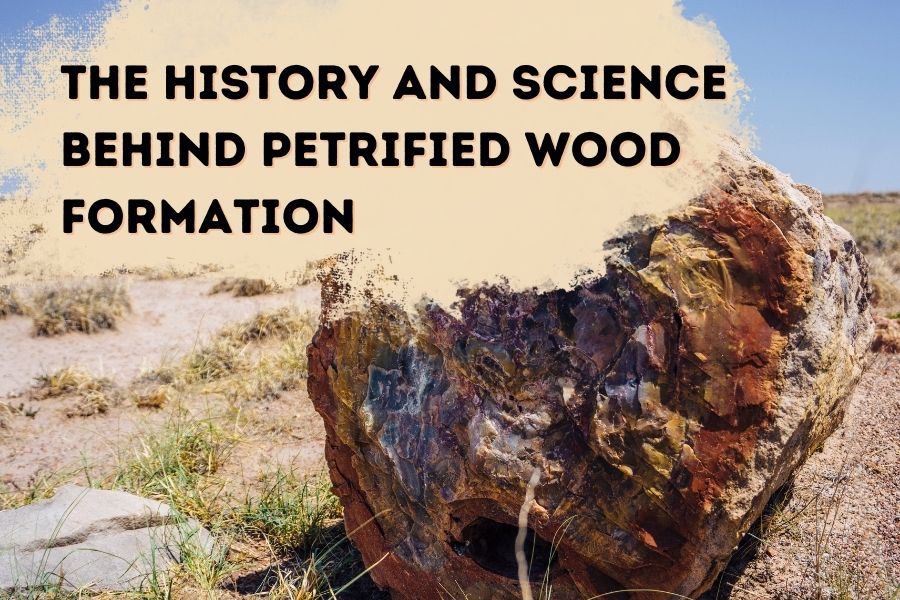Petrified wood is a type of fossil, formed when wood is buried in sediment and replaced by minerals over time. This process, known as petrification, preserves the structure of the wood while turning it into stone.
Petrified wood forms when wood is buried in sediment and minerals, such as silica, replace the organic material over time. This process can take millions of years and typically occurs in a low-oxygen environment where bacteria cannot decompose the wood.
As the minerals replace the wood, they take on the shape and structure of the original wood, preserving the tree’s cell structure and details such as bark and branches. In this way, petrified wood is a fossil, a record of ancient life preserved in stone.

History of Petrified Wood
Petrified wood has been known and used by humans for thousands of years. Some of the earliest known discoveries of petrified wood date back to ancient Egypt, where it was used for decorative and functional purposes such as amulets, bowls, and statues. The ancient Greeks and Romans also used petrified wood as decorative items and for carving. In the Middle Ages, petrified wood was thought to have medicinal properties and was used in folk medicine.
In more recent history, petrified wood was used by indigenous people in North America for tools and weapons. Early European settlers also used petrified wood for building materials and as a decorative item. The petrified forest in Arizona was a popular tourist destination in the late 1800s, and petrified wood continues to be a popular collector’s item today.
Petrified wood has also been used in the modern world in many ways such as in construction, flooring, decorative stone, and as an ornamental stone in gardens and landscaping.
What is the cultural importance of petrified wood?
Petrified wood has held cultural significance for many different societies throughout history. In ancient Egypt, it was used for decorative and functional purposes, such as amulets, bowls, and statues.
The ancient Greeks and Romans also used petrified wood as decorative items and for carving. In the Middle Ages, petrified wood was thought to have medicinal properties and was used in folk medicine.

Indigenous people in North America used petrified wood for tools and weapons, and it was also used by early European settlers for building materials and as a decorative item. Petrified wood has also been used in religious and spiritual practices, such as in some indigenous cultures where it is believed to have a connection to the spirit world.
Petrified wood is also valued as a natural and scientific phenomena, some places like Petrified forest National park in Arizona is a popular tourist destination and a natural wonder that many people would like to visit to see the petrified wood.
Petrified wood holds cultural, historical, scientific and aesthetic importance. It is a symbol of ancient life, history and natural wonder.
How old is the oldest piece of petrified wood?
According to scientific research, some of the oldest known petrified wood is found in The Gilboa fossil forest, located in the Catskill Mountains of upstate New York.
This ancient forest, dating back 385 million years, is considered to be the oldest known fossil forest.

The Science of Petrification
Petrification is the process by which wood is transformed into stone through the replacement of its organic material with minerals, mainly silica. The process starts when wood is buried in sediment and is cut off from the oxygen in the air.
Without oxygen, decay-causing bacteria cannot break down the wood, and the organic material begins to be replaced by minerals.
Silica, a mineral that is abundant in nature, is typically the mineral that replaces the organic material in the process of petrification. Silica can be present in the sediment as dissolved silica or as solid silica in the form of crystals such as quartz.

As the silica minerals slowly infiltrate the wood, they begin to replace the organic material, cell by cell. Over time, the wood is completely replaced by silica, preserving the wood’s structure and details such as bark and branches.
The process of petrification can take millions of years, and the final product is a rock that is almost identical in structure to the original wood, but harder and more durable.
Silica plays a crucial role in the petrification process by providing the mineral that replaces the organic material, it is the main mineral that creates the petrified wood, without silica petrification could not happen.
Which Factors Affect petrification
Several factors that can affect the process of petrification and the final outcome of the fossilized wood.
- The presence of mineral-rich fluids, such as groundwater, that can seep into the organism and replace its tissue with minerals over time.
- The conditions under which the organism is buried, such as the presence of oxygen and bacteria.
- The rate of petrification can be influenced by the type of organism and the environment in which it lived.
- The type of sediment or rock surrounding the organism can also play a role in the preservation process.
- Climate and weather conditions can also affect how quickly the petrification process occurs.
- The rate of erosion, also plays a role in the preservation of fossils over time.
- The Taphonomy, which is the study of how organisms become fossils, also plays a role in the petrification process.
- The pressure, temperature, and chemical composition of the surrounding environment also affect the process.
It’s important to note that the process of petrification is a complex one and may be affected by a variety of factors that are not mentioned here though.
Types of Petrified Wood
There are several types of petrified wood, each characterized by the type of mineral that has replaced the original wood tissue.
Some of the most common types include:
- Silicified wood: Often in the form of quartz.
- Calcified wood: Characterized by the replacement of the original wood tissue with calcite or other carbonate minerals.
- Pyrite wood: Also known as pyrite.

- Opalized wood: A hydrated form of silica.
- Sideritized wood: This type of petrified wood is characterized by the replacement of the original wood tissue with iron minerals, such as siderite.
- Chalcedonized wood: A microcrystalline form of silica.
It’s also important to note that petrified wood can also be a combination of different types of minerals and also some other minerals can form, like hematite, limonite, etc.
What’s the Importance of preserving petrified wood
Petrified wood is an important scientific and cultural resource that can provide valuable information about past environments and life forms. Preserving petrified wood helps to ensure that this resource will be available for future scientific study and educational use.
- Scientific importance: Petrified wood can provide scientists with information about past environments, the types of plants that lived in those environments, and the changes that have occurred over time. This information can be used to reconstruct past environments, understand the evolution of plant life, and study the effects of climate change on ecosystems.
- Educational importance: Petrified wood is a valuable educational resource that can be used to teach about the natural world, geology, and the history of life on Earth.
- Cultural importance: Petrified wood is also of cultural importance and can be used to tell the story of past human societies and their relationship with the natural world. It can be used to tell the history of human habitation in a particular area, and as a reminder of the importance of preserving the natural world for future generations.
- Economic importance: Petrified wood can also be a valuable resource for the economy, as it can be used for decorative and ornamental purposes, such as in sculpture and jewelry making.
Preserving petrified wood can also help to protect it from looting, vandalism, and other types of damage, and ensure that it will be available for future generations to study, appreciate, and enjoy.

Efforts to conserve and protect petrified wood sites
Depending on the location and other factors, generally current efforts to conserve and protect petrified wood sites include:
- Protected areas: Petrified wood sites are often protected within national parks, nature reserves, and other protected areas. These protected areas help to ensure that the petrified wood is not removed from the site, and that the site is not damaged by human activity.
- Scientific research: Scientists are conducting research on petrified wood sites to better understand the geology and biology of the area, and to develop conservation strategies.
- Education and outreach: Many organizations and government agencies are working to educate the public about the importance of petrified wood sites and the importance of preserving them for future generations.
- Monitoring and surveillance: Many petrified wood sites are regularly monitored to detect any signs of looting, vandalism, or other damage.
- Restoring and Rehabilitation: In cases where petrified wood sites have been damaged by human activity, conservation efforts may include restoring the site and rehabilitation of the affected area.
- Laws and regulation: Petrified wood is protected by laws and regulations in many countries, and it is illegal to remove or damage it in those areas.
- International cooperation: There are also international efforts to protect petrified wood, such as the Convention on the trade of endangered species of wild fauna and flora (CITES) which also covers some species of petrified wood.
Conclusion
In conclusion petrified wood is a fascinating and important part of our natural heritage, and there are many ways to learn more about and appreciate it.
You can visit local petrified wood sites, learn about the geology and biology of the area, and learn about the conservation efforts that are in place to protect it.
You can also visit museums and educational centers that have exhibits on petrified wood, read books and articles on the subject, and participate in educational programs and tours that focus on petrified wood.
By learning more about and appreciating petrified wood, we can help to ensure that this valuable resource will be available for future generations to study and enjoy.


